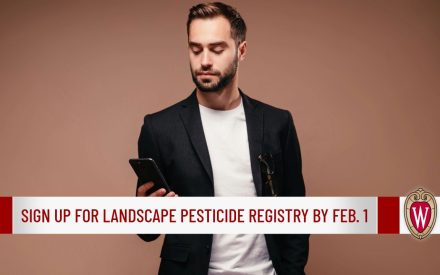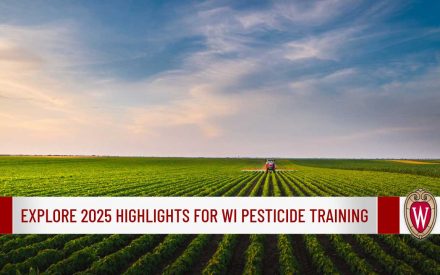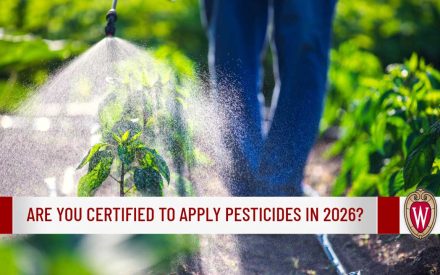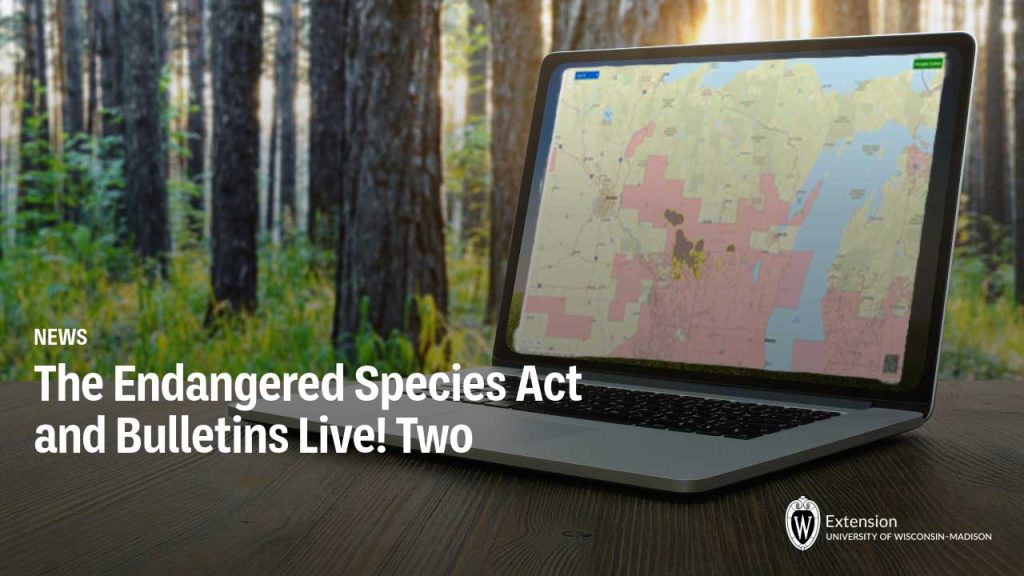
What is the Endangered Species Act?
The Endangered Species Act (ESA) of 1973 is designed to protect endangered and threatened species. Sections of this act make the killing, harming, or harassing of these species illegal. The act also protects the critical habitat of listed species as habitat loss is the leading cause of their disappearance.
This law is administered by the U.S. Fish and Wildlife Service (FWS) and the National Marine Fisheries Service (NMFS). These federal agencies are largely responsible for determining and keeping a list of species of concern. Table 1 ⚓ lists the current endangered and threatened species in Wisconsin. Even though FWS and NMFS are responsible for this law, the ESA states that other agencies (e.g., Environmental Protection Agency) must work towards the same goal.
Part of the Environmental Protection Agency’s (EPA) responsibility is to evaluate the risks related to pesticide use. This means that when the EPA registers a pesticide, they must determine if the use of that pesticide could cause harm to endangered species or their critical habitat. As you might imagine, this can be a complicated and interesting balancing act.
How does the EPA ensure compliance with the ESA?
To be compliant with the ESA, the EPA utilizes mandatory pesticide label requirements and a system called Bulletins Live! Two, both of which need to be consulted prior to using a pesticide. Bulletins Live! Two ↗️ is a website that provides additional warnings, requirements, and restrictions for pesticide use based on geographic location. These geographic restrictions are called Pesticide Use Limitation Areas (PULAs). In addition to following the pesticide label, PULAs were developed to further mitigate the impacts of pesticides on endangered species and their habitats. Currently, there are only a few products registered for use in Wisconsin that have Endangered Species Protection Bulletins, but moving forward, this could change as new pesticide products are registered or new endangered or threatened species are listed. The ESA language on both the full pesticide label and in the bulletins are specifically intended to reduce the risk of pesticide drift and runoff/erosion.
In recent years, the EPA has developed a workplan to meet ESA compliance. The workplan will outline a strategy for each group of pesticides (e.g., herbicide, insecticide, fungicide, etc.) to ensure all product registrations and re-registrations are ESA compliant. The final Herbicide Strategy ↗️ was released in late August 2024, followed by the final Insecticide Strategy ↗️ in late April 2025. Within both strategies, Bulletins Live! Two has become a more prevalent tool that applicators will need to access prior to any pesticide applications, in addition to following the full pesticide label.
Do I need to use Bulletins Live! Two?
Read the Pesticide Label
Read the pesticide label thoroughly. With the ESA compliance changes, information regarding Bulletins Live! Two may be found in different sections on various types of products.
Pay particular attention to the Environmental Hazards, Endangered Species or the Mandatory Runoff Mitigation sections of labels. If there is a bulletin for the product you wish to use, a link or phone number to access Bulletins Live! Two will be included in the label (Figure 1 ⚓).
These mandatory statements found within the label indicate you must access Bulletins Live! Two to check for product use restrictions in your area:
- “When using this product, you must follow the measures contained in the Endangered Species Protection Bulletin for the area in which you are applying the product. To obtain Bulletins, no more than six months before using this product, consult https://www.epa.gov/endangered-species-bulletins-live-two-view-bulletins…” (Figure 1 ⚓)
- “Applicators must access and search Bulletins Live! Two (BLT) at https://www.epa.gov/pesticides/bulletins within six months of the application…”(Figure 2 ⚓) (Figure 3 ⚓)
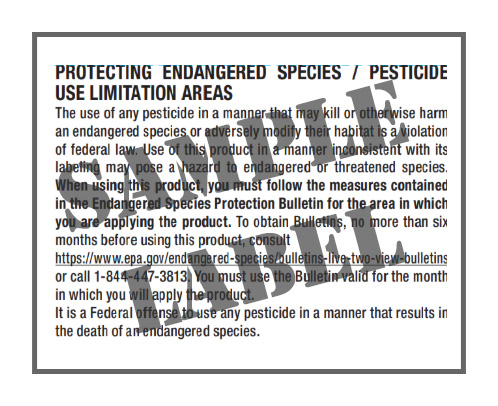
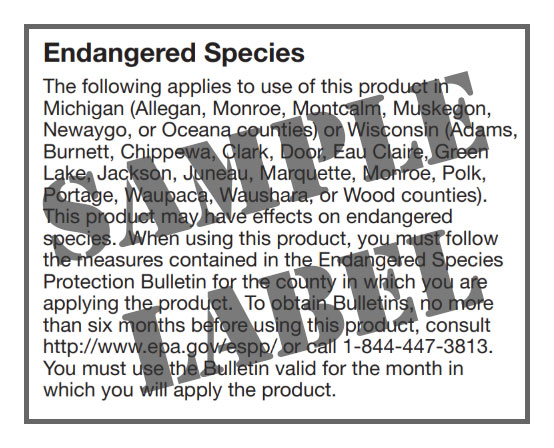

How do I access bulletins on Bulletins Live! Two?
Follow the Link or Call the Number
Accessing bulletins through the Bulletins Live! Two website
When following the link to Bulletins Live! Two ↗️, you will see a map of the United States (Figure 4 ⚓). This map is interactive, and you can zoom in on part of the country or search by location. When searching for active bulletins, you must select or indicate the month that you plan to apply the pesticide. Some bulletins may be time sensitive and only apply during specific times of the year.
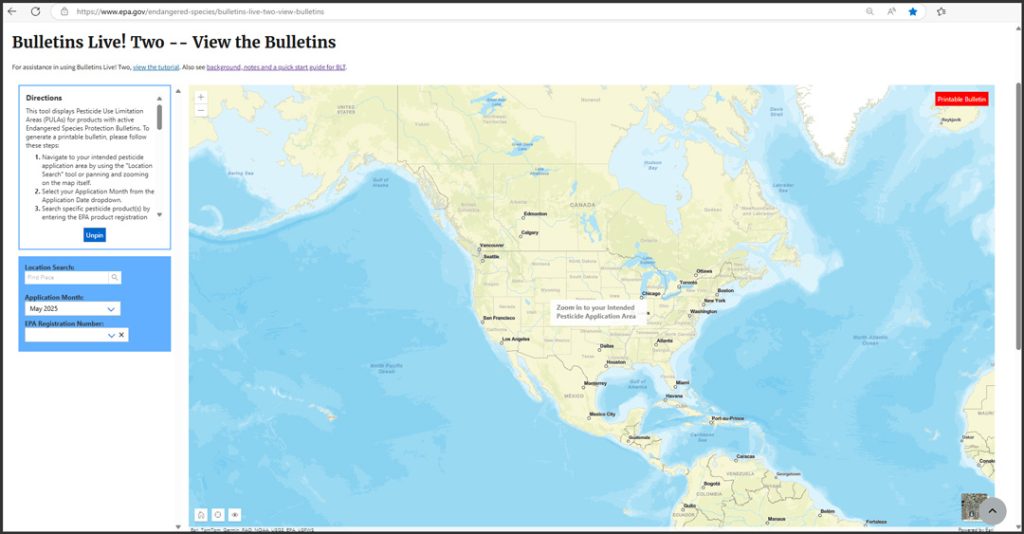
Find bulletins for a specific location
The interactive map allows users to find all Pesticide Use Limitation Areas (PULAs) in their region without indicating the EPA registration number of a particular pesticide product.
When applying in Wisconsin, zoom in using the interactive map (Figure 5 ⚓). The pink areas indicate PULAs where there is at least one active Endangered Species Protection Bulletin.

Click on the pink areas for information about the PULAs in the selected area, including specific products (Figure 6 ⚓). If more than one limitation exists in the selected area, multiple tabs may appear on the left to indicate more than one bulletin for that area.

In Figure 6 ⚓, the area outlined in yellow was selected. The information on the left shows the limitations in the selected area, including limitations for dicamba and methoxyfenozide products. Toggle between the “Dicamba – 2020” and “Methoxyfenozide” tabs to identify the specific products.
Find bulletins for a specific pesticide product
If you are accessing Bulletins Live! Two for a specific pesticide product you intend to use, you can search by the product’s EPA registration number. Locate the EPA registration number on the pesticide label and enter it below the application month. You can enter more than one EPA registration number to search at a time. The interactive map will adjust to only show restrictions for the specific pesticides.
When searching by product, Bulletins Live! Two will only display PULAs for the entered products and may not indicate other product restrictions in your area. It is recommended to be aware of all PULAs in your area.

Click on the interactive map to select the PULA. This will display the limitations in a table on the left-hand side of the screen (Figure 7 ⚓). Click the button “Full Details” to display the complete bulletin for those products as a popup (Figure 8 ⚓). Note the popup may not work if you have popup blockers on your computer. If you are searching an area with multiple PULAs, be careful that you are on the correct tab.
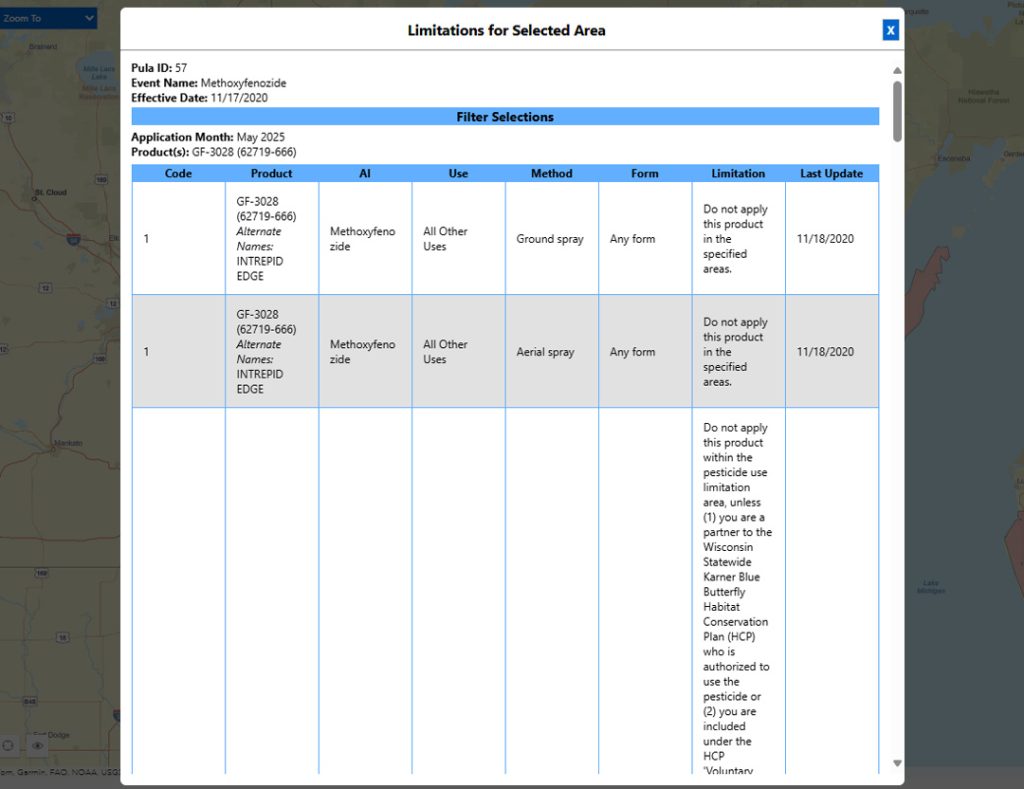
A printable format of the bulletin can be downloaded and saved as a PDF to provide to clients or keep with your records (Figure 9 ⚓). Scroll to the bottom of the popup “Full Details” bulletin and click “Printable Bulletin” or click “Printable Bulletin” on the top right corner of the interactive map.
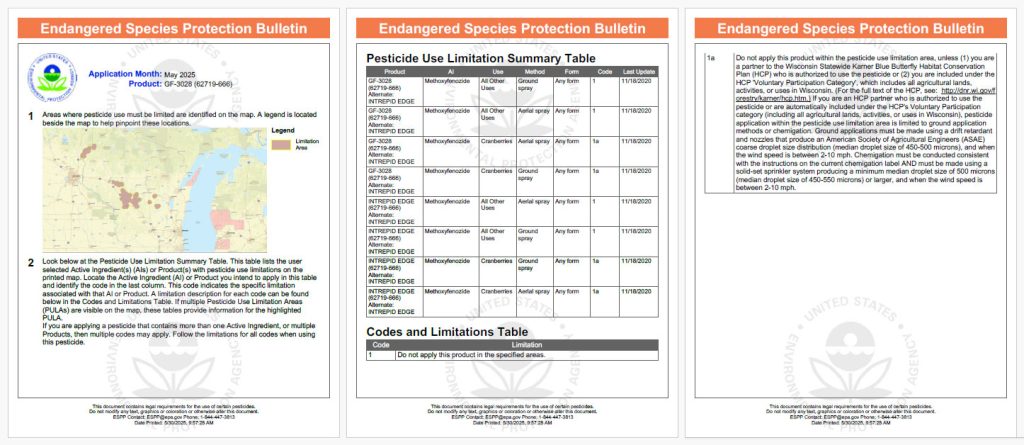
Accessing bulletins by phone
If you call the phone number instead of accessing the website, you can leave a message providing your location, the EPA registration number of the product you plan to use, and the planned application month. If you don’t know the EPA registration number, ask for all bulletins for the application month and location. Someone from the EPA will reach out to you with your requested information.
Why should I access Bulletins Live! Two?
The pesticide label is the law. It is a legally binding document, and you must follow all the instructions outlined in the label. If the label requires you to access Bulletins Live! Two or call the phone number, you must do it.
Although Wisconsin currently only has a few bulletins at this time, pesticide products are registered and reregistered frequently. Bulletins may be added or revised at any time, so be sure to check the Bulletins Live! Two site often and prior to any pesticide use.
Endangered and threatened species in Wisconsin
| Group | Status | Common Name [ Scientific name ] |
| Bird | Endangered | Piping plover [ Chardrius melodus ] |
| Experimental Pop | Whooping crane [ Crus Americana ] | |
| Threatened | Red knot [ Calidris canutus rufa ] | |
| Clam | Endangered | Higgins eye (perlymussel) [ Lampsillis higginsii ] |
| Endangered | Winged mapleleaf [ Quadrula fragosa ] | |
| Endangered | Spectaclecase [ Cumberlandia monodonta ] | |
| Endangered | Snuffbox mussel [ Epioblasma tiguetra ] | |
| Endangered | Sheepnose mussel [ Plethobasus cyphyus ] | |
| Flowering Plants | Threatened | Northern wild monkshood [ Aconitum noveboracense ] |
| Threatened | Mead’s milkweed [ Asclepias meadii ] | |
| Threatened | Pitcher’s thistle [ Cirsium pitcheri ] | |
| Threatened | Dwarf lake iris [ Iris lacustris ] | |
| Threatened | Prairie bush-clover [ Lespedeza leptostachya ] | |
| Threatened | Fassett’s locoweed [ Oxytropis campestris var. chartacea ] | |
| Threatened | Eastern prairie fringed orchid [ Platanthera leaucophaea ] | |
| Insects | Endangered | Karner Blue butterfly [ Lycaeides melissa samuelis ] |
| Endangered | Hine’s emerald dragonfly [ Somatochlora hineana ] | |
| Endangered | Poweshiek skipperling [ Oarisma Poweshiek ] | |
| Endangered | Rusty patched bumble bee [ Bombus affinis ] | |
| Mammal | Endangered | Gray wolf [ Canis lupus ] |
| Threatened | Canada lynx [ Lynx Canadensis ] | |
| Endangered | Indiana bat [Myotis sodalist] | |
| Endangered | Northern long-eared bat [ Myotis septentrionalis ] | |
| Reptile | Threatened | Eastern rattlesnake [ Sistrurus catenatus ] |
| Snail | Endangered | Iowa Pleistocene snail [ Discus macclintocki ] |
Taken from US FWS ECOS Environmental Conservation Online System ↗️
[ Accessed 5/15/2025; please note that this list is subject to change].
Last updated: May 27, 2025
Reviewed by: Otto Oemig (DATCP), Dan Smith (UW-Madison) and Jed Colquhoun (UW-Madison)
Additional Resources
- Learn more about the Endangered Species Act ↗️
- Learn more about endangered and threatened species in Wisconsin ↗️
- View the EPA’s final Herbicide Strategy ↗️
- View the EPA’s final Insecticide Strategy ↗️
- Access Bulletins Live! Two website ↗️
References
Pesticide Applicator Training News

